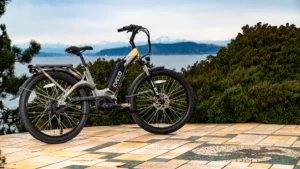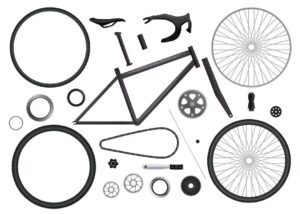كعنصر محوري في الدراجة, تساعد شوكة التعليق الأمامية على تخفيف تأثير التضاريس غير المستوية, امتصاص الصدمات, والحفاظ على الجر, وبالتالي تعزيز راحة الراكب, يتحكم, والأداء العام. سواء معالجة المسارات الصخرية, التنقل عبر المسارات المحملة بالجذور, أو ببساطة الإبحار فوق العوائق الحضرية, إن وجود شوكة تعليق أمامية موثوقة يمكن أن يحدث فرقًا كبيرًا في جودة الركوب والاستمتاع. بوضوح, إن فهم الأنواع المختلفة لشوكات التعليق الأمامية يمكن أن يؤثر بشكل كبير على تجربة الركوب الخاصة بك. يهدف هذا الدليل إلى كشف تعقيدات 11 أنواع شوكات التعليق الأمامية, تزويدك بالمعرفة لاتخاذ قرار مستنير يناسب احتياجات ركوب الدراجات الخاصة بك.
ما هي شوكة التعليق?
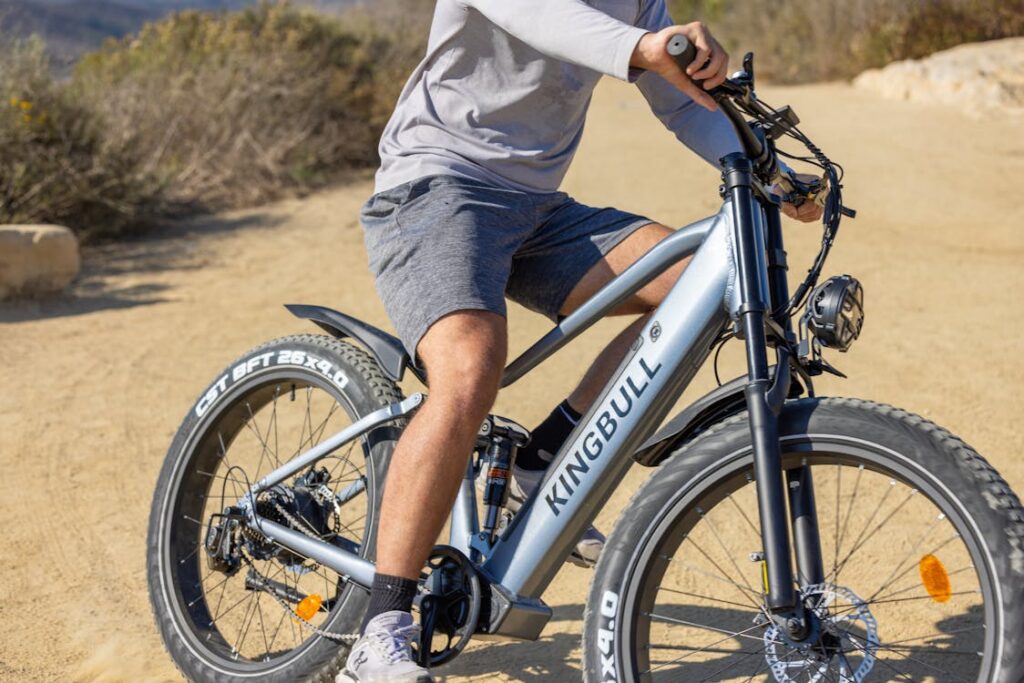
شوكة تعليق, مصنوعة من مواد مثل الألومنيوم, ألياف الكربون, أو الصلب, يشتمل على نظام من الأنابيب التلسكوبية التي تحتوي على نوابض, مخمدات, وغيرها من الآليات. تعمل هذه المكونات بشكل تآزري لامتصاص الصدمات, تعزيز الجر, وتسهيل التنقل بشكل أكثر سلاسة على الأراضي الوعرة. تعمل هذه الأعجوبة الهندسية على تمكين راكبي الدراجات من التعامل مع الأسطح غير المستوية براحة أكبر, استقرار, والثقة, ضمان تجربة ركوب مبهجة ومراقبة.
ويأتي في تصاميم متنوعة, يقدم كل منها ميزات مميزة, المزايا, والقيود. بدءًا من شوكات النوابض اللولبية التقليدية وحتى أنواع النوابض الهوائية المبتكرة, ومن العجائب الهيدروليكية إلى العجائب الميكانيكية, الشركة المصنعة لشوكة الدراجة يلبي مجموعة واسعة من التفضيلات وأساليب الركوب. إن فهم الفروق الدقيقة في أنواع شوكة تعليق الدراجة يُمكِّن راكبي الدراجات من اتخاذ قرارات مستنيرة ومصممة خصيصًا لتلبية احتياجاتهم وتفضيلاتهم الخاصة.
شوكات تعليق الزنبرك الهوائي
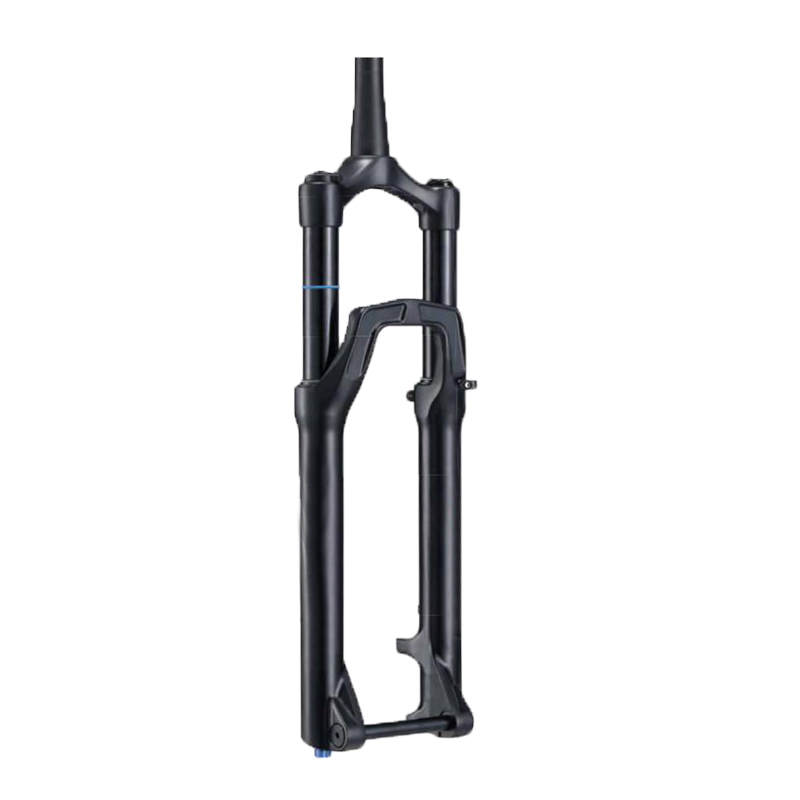
تستخدم شوكات التعليق الزنبركي الهوائي غرف الهواء المضغوط لتوفير أداء تعليق قابل للتعديل مصمم خصيصًا لتفضيلات الراكب وظروف التضاريس. هذه الشوكات مفضلة لبنيتها خفيفة الوزن, توليه, والاستجابة, تقديم تجربة ركوب قابلة للتخصيص لتناسب مجموعة واسعة من التفضيلات.
إيجابيات وسلبيات
إيجابيات:
- هيكل خفيف الوزن يقلل من الوزن الإجمالي للدراجة, تعزيز خفة الحركة والقدرة على المناورة.
- يسمح ضغط الهواء القابل للتعديل للركاب بضبط خصائص التعليق لتناسب التضاريس المختلفة وأنماط الركوب.
- يوفر الأداء سريع الاستجابة امتثالًا ودعمًا ممتازين للمطبات الصغيرة أثناء الركوب العدواني.
سلبيات:
- قد يتطلب الإعداد والضبط الأولي بعض الخبرة لتحقيق الأداء الأمثل.
- تكون أختام الهواء والغرف عرضة للتلف الناتج عن الحطام والصدمات, مما يستلزم الصيانة الدورية.
- تكلفة أولية أعلى مقارنة بشوكات الزنبرك اللولبي, يحتمل أن يردع راكبي الدراجات المهتمين بالميزانية.
العناية النموذجية بالشوكات الهوائية
تتطلب الشوكات الهوائية عادةً زيتًا لأغراض التشحيم والتخميد. بينما توفر غرفة الهواء آلية الزنبرك, يعتبر الزيت ضروريًا لتشحيم المكونات الداخلية مثل الأختام, البطانات, ودوائر التخميد لضمان أداء سلس ومتسق مع مرور الوقت.
شوكات التعليق الهيدروليكية
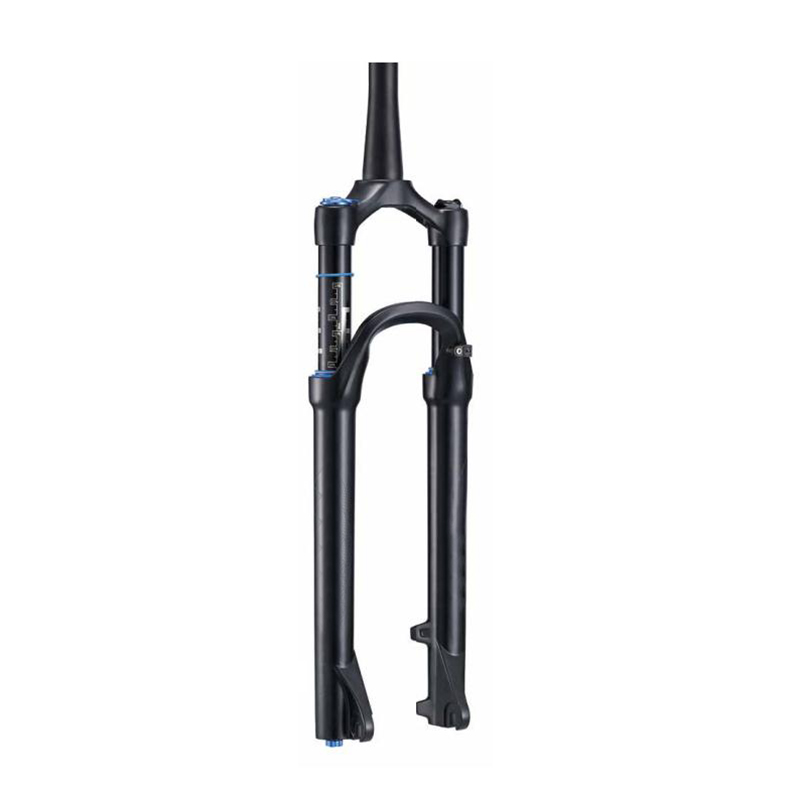
تستخدم شوكات التعليق الهيدروليكية أنظمة التخميد القائمة على السوائل لتنظيم الضغط والتخميد الارتدادي, توفر تحكمًا دقيقًا وخصائص تخميد مصممة خصيصًا لتفضيلات الراكب. تشتهر هذه الشوكات بأدائها السلس والمتسق, مما يجعلها مشهورة بين الدراجين المميزين الذين يبحثون عن أداء التعليق الأمثل.
إيجابيات وسلبيات
إيجابيات:
- يوفر التحكم الاستثنائي في التخميد قيادة فخمة ومُحكمة عبر مجموعة متنوعة من التضاريس.
- توفر الأنظمة الهيدروليكية مجموعة واسعة من خيارات التعديل, السماح للركاب بضبط سلوك التعليق حسب رغبتهم.
- أداء ثابت في ظل درجات الحرارة والظروف المختلفة, ضمان أداء موثوق به في أي بيئة ركوب.
سلبيات:
- تكلفة أولية أعلى مقارنة بأنواع شوكة التعليق الأخرى, من المحتمل أن يحد من إمكانية الوصول إلى راكبي الدراجات المهتمين بالميزانية.
- قد تتطلب المكونات الداخلية المعقدة أدوات وخبرة متخصصة للصيانة والخدمة.
- عرضة لتسرب السوائل وتآكل الختم مع مرور الوقت, مما يستلزم الفحص والصيانة الدورية.
شوكات أنبوبية مدببة
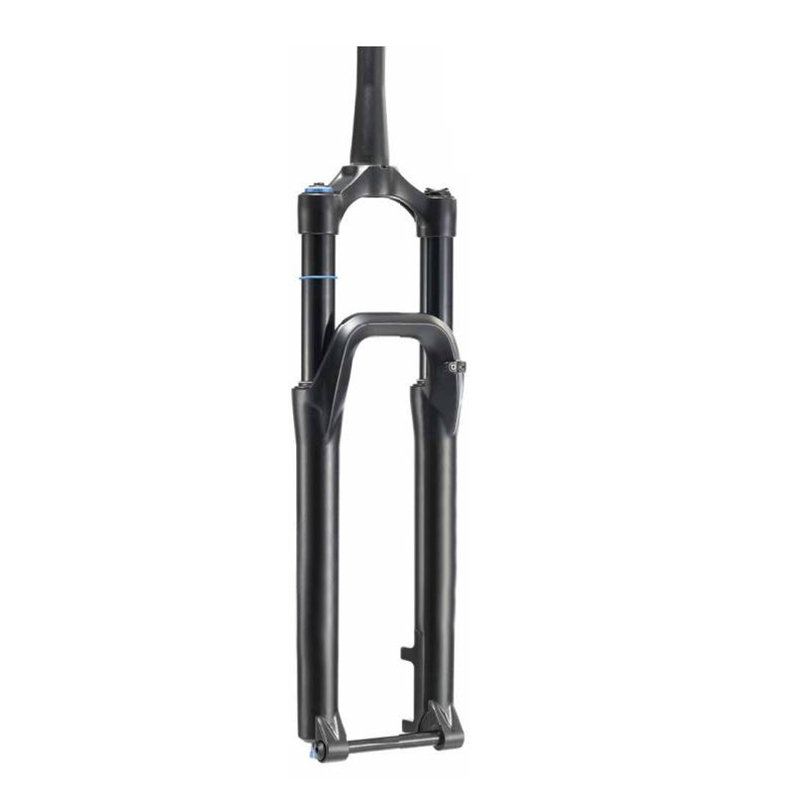
تتميز شوكات أنبوب التوجيه المدببة بتصميم مدبب حيث ينتقل قطر أنبوب التوجيه من الأبعاد الأكبر إلى الأبعاد الأصغر, تقدم صلابة معززة, قوة, والتوافق مع تصميمات الإطارات الحديثة وتكوينات أنبوب الرأس.
إيجابيات وسلبيات
إيجابيات:
- تحسين الصلابة ودقة التوجيه مقارنة بشوكات أنبوب التوجيه المستقيمة, خاصة في ظل الأحمال الثقيلة أو مناورات القيادة العدوانية.
- توافق محسّن مع الأشكال الهندسية الحديثة للإطار ومعايير أنبوب الرأس, ضمان اعتماد واسع النطاق عبر نماذج وتخصصات الدراجات المختلفة.
- انخفاض في الوزن مقارنة بالشوكات الأنبوبية المستقيمة التقليدية, تحسين خفة الحركة الشاملة للدراجة والقدرة على المناورة.
سلبيات:
- توافق محدود مع تصميمات الإطارات القديمة ومعايير سماعات الرأس, من المحتمل أن تتطلب تعديل الإطار أو حلول المحول للتعديل التحديثي.
- تكلفة أعلى مقارنة بشوكات أنبوب التوجيه المستقيمة, خاصة في نماذج الشوكة المتميزة التي تتميز بمواد وتقنيات تصنيع متقدمة.
- تتطلب مشكلات التوافق المحتملة مع مكونات جذع وسماعة الرأس ما بعد البيع دراسة متأنية أثناء تجميع الدراجة وتخصيصها.
اعتبارات التوافق لشوكات أنبوب التوجيه المدببة
عند اختيار شوكة أنبوبية مدببة, يجب على الدراجين التأكد من التوافق مع أبعاد أنبوب رأس إطار الدراجة ومواصفات سماعات الرأس. بالإضافة إلى ذلك, التحقق من التوافق مع مكونات جذع وسماعة الرأس ما بعد البيع يمكن أن يمنع مشكلات التوافق ويضمن التكامل السلس مع إعدادات الدراجة الحالية.
شوكات أنبوبية مستقيمة
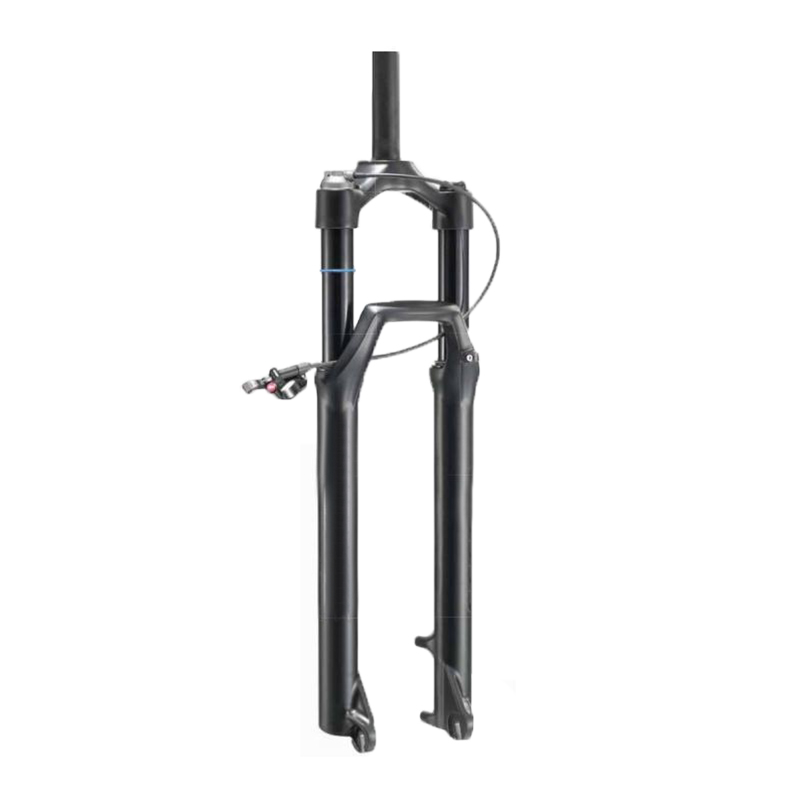
تتميز شوكات أنبوب التوجيه المستقيمة بتصميم أنبوب توجيه ذو قطر موحد, تقديم البساطة, التنوع, والتوافق مع مجموعة واسعة من تصميمات الإطارات ومعايير سماعات الرأس. بينما يكون أقل شيوعًا في الدراجات الحديثة عالية الأداء, تظل شوكات أنبوب التوجيه المستقيمة شائعة في بعض التطبيقات ونماذج الدراجات الصديقة للميزانية.
إيجابيات وسلبيات
إيجابيات:
- توافق متعدد الاستخدامات مع الأشكال الهندسية المختلفة للإطارات ومعايير سماعات الرأس, ضمان اعتماد واسع النطاق عبر نماذج وتخصصات مختلفة للدراجات.
- تجميع وصيانة مبسطة مقارنة بشوكات أنبوب التوجيه المدببة, تقليل نقاط الفشل المحتملة ومشكلات التوافق.
- خيار فعال من حيث التكلفة لراكبي الدراجات المهتمين بالميزانية أو أولئك الذين يبحثون عن حل تعليق أساسي دون تعقيد الأنظمة المتقدمة.
سلبيات:
- انخفاض الصلابة ودقة التوجيه مقارنة بشوكات أنبوب التوجيه المدببة, خاصة في ظل الأحمال الثقيلة أو مناورات القيادة العدوانية.
- التوفر المحدود لخيارات شوكة أنبوب التوجيه المستقيمة عالية الأداء, من المحتمل أن يؤدي ذلك إلى تقييد الخيارات أمام الدراجين الذين يبحثون عن ميزات وتقنيات التعليق المتقدمة.
- عقوبة الوزن المحتملة مقارنة بشوكات أنبوب التوجيه المدببة, خاصة في النماذج التي تحتوي على أنابيب توجيه من الفولاذ أو السبائك.
الاستخدامات الشائعة لشوكات أنبوب التوجيه المستقيمة
على الرغم من تراجع شعبيتها في تصاميم الدراجات عالية الأداء, تظل شوكات أنبوب التوجيه المستقيمة سائدة في بعض التطبيقات مثل التنقل في المناطق الحضرية, ركوب الترفيهية, وركوب الدراجات الجبلية للمبتدئين.
نصائح لصيانة شوكات التعليق الهيدروليكية
للحفاظ على الأداء الأمثل وطول عمر شوكات التعليق الهيدروليكية, التفتيش المنتظم للأختام, مستويات السوائل, وإعدادات التخميد ضرورية. بالإضافة إلى ذلك, يمكن أن يؤدي اتباع فترات الخدمة الموصى بها من قبل الشركة المصنعة واستخدام سوائل التعليق عالية الجودة إلى إطالة عمر المكونات الهيدروليكية وضمان الأداء المتسق بمرور الوقت.
شوكات تعليق القفل
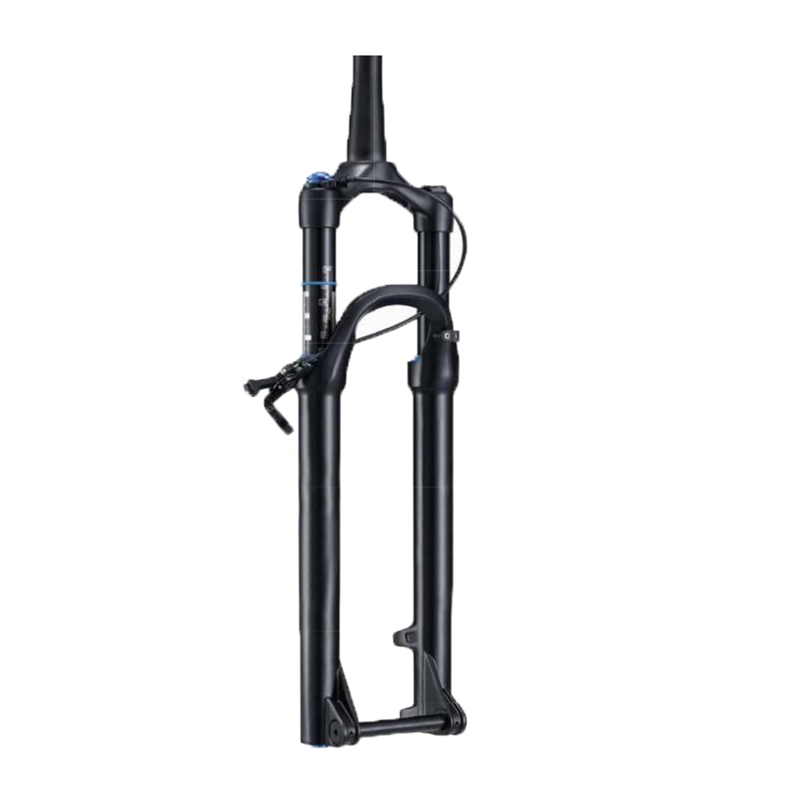
تتميز شوكات التعليق المغلقة بآلية ميكانيكية أو هيدروليكية تسمح للركاب بتعطيل حركة التعليق مؤقتًا, بشكل فعال “تأمين” الشوكة وتحويلها إلى منصة صلبة. تعتبر هذه الميزة مفيدة بشكل خاص للحفاظ على كفاءة استخدام الدواسات في المقاطع الملساء أو المرتفعة من الممرات حيث تكون حركة التعليق غير ضرورية.
إيجابيات وسلبيات
إيجابيات:
- تحسين كفاءة استخدام الدواسات ونقل الطاقة على التضاريس الملساء أو الشاقة, بفضل المنصة الصلبة التي توفرها آلية القفل.
- أداء محسّن للتسلق والجر عن طريق تقليل فقدان الطاقة من خلال تمايل التعليق والحركة.
- يضمن التوافق متعدد الاستخدامات مع تصميمات الإطارات المختلفة وأنماط الركوب اعتمادًا واسع النطاق عبر نماذج وتخصصات الدراجات المختلفة.
سلبيات:
- تقليل الراحة والتحكم على الأراضي الوعرة أو التقنية عند قفل نظام التعليق, من المحتمل أن يؤثر ذلك على الجر والتعامل.
- زيادة التعقيد مقارنة بالشوكات غير القابلة للقفل, مما قد يؤدي إلى ارتفاع متطلبات الصيانة ونقاط الفشل.
- عرضة لمشاكل التوافق مع مكونات الجذع والمقود ما بعد البيع, مما يستلزم دراسة متأنية أثناء تجميع الدراجة وتخصيصها.
كيفية الاستفادة من ميزة التأمين بشكل فعال
للاستفادة من ميزة القفل بشكل فعال, يجب على الدراجين تشغيل آلية القفل عند مواجهة أقسام سلسة أو شاقة من الممرات حيث تكون حركة التعليق غير ضرورية أو تضر بكفاءة استخدام الدواسات. على العكس, يجب عليهم فك قفل القفل عند النزول أو الركوب فوق الأراضي الوعرة لتحقيق أقصى قدر من الراحة, الجر, والتحكم الذي توفره شوكة التعليق. إن تجربة إعدادات القفل المختلفة ومراقبة التأثيرات على كفاءة استخدام الدواسات وجودة الركوب يمكن أن تساعد الدراجين على تحسين إعداد التعليق الخاص بهم لظروف وتفضيلات المسار المختلفة.
شوكات تعليق زنبركية ملفوفة
تستخدم شوكات التعليق الزنبركية اللولبية زنبركًا معدنيًا ملفوفًا لامتصاص الصدمات وتوفير التوسيد أثناء الركوب. هذه الشوكات معروفة بمتانتها, مصداقية, والأداء المتسق عبر مختلف التضاريس. غالبًا ما يمكن تعديل خصائص الضغط والارتداد لشوكات الزنبرك اللولبي لتناسب تفضيلات الراكب الفردية.
إيجابيات وسلبيات
إيجابيات:
- البناء القوي يضمن طول العمر والموثوقية.
- بشكل عام أكثر بأسعار معقولة مقارنة بأنواع شوكة التعليق الأخرى.
- الحد الأدنى من متطلبات الصيانة, مما يجعلها مثالية للراكبين الذين يبحثون عن أداء خالٍ من المتاعب.
سلبيات:
- عادة ما تكون أثقل من نظيراتها من الزنبركات الهوائية, من المحتمل أن تؤثر على الوزن الإجمالي للدراجة.
- إمكانية تعديل محدودة مقارنة بأنظمة التعليق الأكثر تقدمًا.
- قد تجربة “ربط الملف” تحت ضغط شديد, مما يؤدي إلى انخفاض فعالية التعليق.
أفضل الاستخدامات لشوكات الزنبرك الملفوف
تتفوق شوكات التعليق الزنبركية اللولبية في التطبيقات التي تتطلب المتانة, بساطة, والقدرة على تحمل التكاليف أمر بالغ الأهمية. إنها مناسبة تمامًا للدراجات الجبلية للمبتدئين, دراجات ركاب, والراكبون الترفيهيون الذين يبحثون عن أداء تعليق موثوق دون تعقيد الأنظمة الأكثر تطورًا.
شوكات التعليق الميكانيكية
شوكات التعليق الميكانيكية, تُعرف أيضًا باسم شوكات المطاط الصناعي, الاستفادة من المواد المرنة لتوفير التوسيد وامتصاص الصدمات أثناء الركوب. في حين أنه أقل شيوعا في تصاميم الدراجات الحديثة, توفر الشوكات الميكانيكية البساطة, مصداقية, ومتطلبات الصيانة المنخفضة, مما يجعلها مناسبة للركاب العاديين والركاب في المناطق الحضرية.
إيجابيات وسلبيات
إيجابيات:
- تصميم بسيط وموثوق يقلل من متطلبات الصيانة ونقاط الفشل المحتملة.
- هيكل خفيف الوزن يعزز خفة الحركة والقدرة على المناورة بالدراجة, خاصة في البيئات الحضرية.
- خيار فعال من حيث التكلفة لراكبي الدراجات المبتدئين أو أولئك الذين يبحثون عن حل تعليق أساسي دون تعقيد الأنظمة المتقدمة.
سلبيات:
- إمكانية تعديل محدودة مقارنة بأنواع شوكة التعليق الأخرى, من المحتمل أن يؤثر ذلك على جودة الركوب والأداء.
- عرضة للتدهور وفقدان الأداء بمرور الوقت مع تآكل المواد المرنة.
- بشكل عام، تكون أقل فعالية في تخميد التأثيرات عالية التردد مقارنة بالشوكات الهيدروليكية أو الشوكات الزنبركية الهوائية.
فروق الأداء بين الأنواع الميكانيكية والأنواع الأخرى من الشوكات
بينما توفر شوكات التعليق الميكانيكية البساطة والموثوقية, قد لا توفر نفس المستوى من الضبط, فخم, والأداء كأنظمة تعليق أكثر تقدمًا. الدراجون يبحثون عن أقصى قدر من التحكم, قابلية التعديل, وقد تفضل الراحة خصائص التخميد الفائقة وقابلية الضبط التي توفرها الشوكات الهيدروليكية أو الزنبركية الهوائية.
شوكات تعليق مقلوبة
شوكات تعليق مقلوبة, تُعرف أيضًا باسم الشوكات المقلوبة, تتميز بتصميم حيث تكون الدعامات السفلية أكثر سمكًا ومثبتة على التاج, بينما تكون الأنابيب العلوية أرق ومتصلة بمحور العجلة. يوفر هذا التكوين غير التقليدي العديد من المزايا من حيث الصلابة, توزيع الوزن, والاستجابة, خاصة في سيناريوهات الركوب على الطرق الوعرة العدوانية.
إيجابيات وسلبيات
إيجابيات:
- زيادة الصلابة والصلابة مقارنة بشوكات التعليق التقليدية, تعزيز دقة التوجيه والتحكم.
- يعمل الوزن المنخفض غير المعلق على تحسين استجابة التعليق والجر, خاصة أثناء الهبوط عالي السرعة والمناورات الفنية.
- تقليل الالتواء المرن والالتواء تحت الأحمال الثقيلة أو الكبح الشديد, مما يؤدي إلى معالجة واستقرار أكثر قابلية للتنبؤ به.
سلبيات:
- ارتفاع تعقيد التصنيع والتكلفة مقارنة بتصميمات شوكة التعليق التقليدية, من المحتمل أن يحد من إمكانية الوصول إلى نماذج الدراجات المتطورة.
- توافق محدود مع تصميمات إطارات وأحجام معينة للعجلات, تتطلب دراسة متأنية أثناء اختيار الدراجة وتخصيصها.
- قابلية أكبر للتلف الناتج عن الصدمات والحطام بسبب الدعامات المكشوفة, مما يستلزم صيانة يقظة وتدابير وقائية.
التطبيقات التي تتفوق فيها الشوكات المقلوبة
تُفضل شوكات التعليق المقلوبة في تخصصات مثل ركوب الدراجات الجبلية على المنحدرات, رحلة مجانية, وسباق إندورو, حيث أقصى صلابة, يتحكم, والاستجابة لها أهمية قصوى. قد يستفيد الدراجون الذين يبحثون عن أداء لا هوادة فيه في بيئات الطرق الوعرة القاسية من القدرات الفائقة التي توفرها تصميمات الشوكة المقلوبة.
شوكات تعليق ذات تاج واحد
تتميز شوكات التعليق ذات التاج الواحد بتاج شوكة واحد يربط بين الدعامات العلوية والسفلية, تقديم توازن وفورات الوزن, صلابة, وتعدد الاستخدامات مناسب لمجموعة واسعة من تخصصات ركوب الخيل. تحظى هذه الشوكات بشعبية خاصة بين سائقي الدراجات الجبلية بسبب أدائها الشامل وتوافقها مع تصميمات الإطارات المختلفة وأحجام العجلات.
إيجابيات وسلبيات
إيجابيات:
- زيادة الصلابة والصلابة مقارنة بشوكات التعليق التقليدية, تعزيز دقة التوجيه والتحكم.
- يعمل الوزن المنخفض غير المعلق على تحسين استجابة التعليق والجر, خاصة أثناء الهبوط عالي السرعة والمناورات الفنية.
- تقليل الالتواء المرن والالتواء تحت الأحمال الثقيلة أو الكبح الشديد, مما يؤدي إلى معالجة واستقرار أكثر قابلية للتنبؤ به.
سلبيات:
- ارتفاع تعقيد التصنيع والتكلفة مقارنة بتصميمات شوكة التعليق التقليدية, من المحتمل أن يحد من إمكانية الوصول إلى نماذج الدراجات المتطورة.
- توافق محدود مع تصميمات إطارات وأحجام معينة للعجلات, تتطلب دراسة متأنية أثناء اختيار الدراجة وتخصيصها.
- قابلية أكبر للتلف الناتج عن الصدمات والحطام بسبب الدعامات المكشوفة, مما يستلزم صيانة يقظة وتدابير وقائية.
لماذا تحظى الشوكات ذات التاج الواحد بشعبية كبيرة بين سائقي الدراجات الجبلية
تحقق شوكات التعليق ذات التاج الواحد توازنًا متناغمًا بين الوزن, صلابة, والأداء, مما يجعلها خيارات متعددة الاستخدامات عبر البلاد, أثر, وركوب جميع الجبال. يضمن توافقها مع الأشكال الهندسية الحديثة للإطارات وأحجام العجلات اعتمادها على نطاق واسع بين سائقي الدراجات الجبلية الذين يبحثون عن حلول تعليق قادرة على التضاريس المتنوعة وأنماط الركوب.
شوكات تعليق ذات تاج مزدوج
شوكات تعليق ذات تاج مزدوج, تُعرف أيضًا باسم شوكات التاج المزدوج, تتميز بوجود تيجان شوكة مزدوجة تربط الدعامات العلوية والسفلية, تقديم صلابة لا مثيل لها, قوة, ودقة التوجيه مناسبة لأنظمة الركوب القصوى مثل سباقات المنحدرات والركوب الحر.
إيجابيات وسلبيات
إيجابيات:
- تعمل الصلابة والقوة الاستثنائية على تحسين دقة التوجيه والتحكم أثناء مناورات القيادة العدوانية.
- متانة معززة ومقاومة للصدمات تتحمل قسوة سباقات المنحدرات وأنظمة الركوب الحر.
- القدرة على استيعاب نطاقات سفر أطول وأحجام عجلات أكبر لتحقيق أقصى قدر من التغطية للتضاريس وتعدد الاستخدامات.
سلبيات:
- زيادة الوزن مقارنة بتصميمات الشوكة ذات التاج الواحد, من المحتمل أن تؤثر على خفة الحركة الشاملة للدراجة والقدرة على المناورة.
- توافق محدود مع أشكال هندسية معينة للإطارات وأحجام العجلات, مما يستلزم دراسة متأنية أثناء اختيار الدراجة وتخصيصها.
- ارتفاع تكلفة ومتطلبات الصيانة مقارنة بشوكات التعليق التقليدية, الحد من إمكانية الوصول إلى عشاق الإنحدار والقيادة الحرة.
الحالات التي تكون فيها الشوكة ذات التاج المزدوج ضرورية
لا غنى عن شوكات التعليق ذات التاج المزدوج في تخصصات مثل سباقات المنحدرات, رحلة مجانية, وركوب الدراجات في الحديقة, حيث أقصى صلابة, قوة, والتحكم أمر بالغ الأهمية لمعالجة السلالات الفنية, يقفز, ويسقط بثقة. قد يستفيد الدراجون الذين يبحثون عن أداء لا هوادة فيه في التضاريس القاسية وسيناريوهات الركوب القاسية من القدرات التي لا مثيل لها والتي توفرها تصميمات الشوكة ذات التاج المزدوج.
السفر ضبط شوكات التعليق
تتميز شوكات التعليق القابلة للتعديل أثناء السفر بنطاقات سفر قابلة للتعديل, مما يسمح للركاب بضبط أداء التعليق ليناسب التضاريس وأنماط الركوب المختلفة. توفر هذه الشوكات التنوع والقدرة على التكيف, تمكين راكبي الدراجات من تحسين خصائص تعليق دراجتهم لظروف أو تفضيلات محددة.
إيجابيات وسلبيات
إيجابيات:
- نطاقات السفر القابلة للتعديل تلبي التضاريس وأساليب الركوب المختلفة, توفر التنوع والقدرة على التكيف مع ظروف الممرات المختلفة.
- يسمح التخصيص المحسّن للركاب بتحسين أداء التعليق لتفضيلات محددة, سواء كنت تبحث عن الفخامة للنزول القاسي أو الكفاءة للتسلق.
- يضمن التوافق متعدد الاستخدامات مع مجموعة واسعة من تصميمات الإطارات وأحجام العجلات اعتمادًا واسع النطاق عبر نماذج وتخصصات الدراجات المختلفة.
سلبيات:
- زيادة التعقيد مقارنة بشوكات السفر الثابتة, مما قد يؤدي إلى ارتفاع متطلبات الصيانة ونقاط الفشل.
- تكلفة أعلى مقارنة بالشوكات غير القابلة للتعديل, خاصة في الطرازات المتميزة التي تتميز بتقنيات التخميد المتقدمة وآليات ضبط السفر.
- عرضة لمشاكل التوافق مع مكونات جذع وسماعة ما بعد البيع, مما يستلزم دراسة متأنية أثناء تجميع الدراجة وتخصيصها.
كيفية ضبط السفر على هذه الشوكات بشكل صحيح?
لضبط السفر بشكل صحيح على السفر، قم بضبط شوكات التعليق, يجب على الدراجين التعرف على توصيات الشركة المصنعة وتعليماتها الخاصة بنموذج الشوكة المحدد الخاص بهم. يتضمن هذا عادةً ضبط ضغط الهواء, إعدادات التحميل المسبق, أو الفواصل الداخلية لتعديل نطاق سفر الشوكة وخصائص الترهل. إن تجربة إعدادات مختلفة ومراقبة التأثيرات على جودة الركوب والأداء يمكن أن تساعد الدراجين على الاتصال بإعدادات التعليق الخاصة بهم لتناسب تفضيلاتهم وظروف الركوب.
ما يجب مراعاته عند الاختيار من بين أنواع مختلفة من شوكات التعليق?
عند الاختيار من بين أنواع مختلفة من شوكات الدراجة, يجب على الدراجين النظر في عوامل مثل:
- نوع التعليق (ربيع لفائف, ربيع الهواء, هيدروليكي, ميكانيكية, إلخ.)
- نطاق السفر وقابلية التعديل
- ميزات التخميد وقابلية التعديل
- التوافق مع إطار الدراجة وحجم العجلة
- الوزن والصلابة
- الميزانية والقيمة مقابل المال
نصائح لاختبار أنواع مختلفة من شوكات الدراجة قبل اتخاذ القرار
لاختبار شوكات التعليق الجيدة قبل اتخاذ القرار, يمكن للدراجين:
- دراجات تجريبية مجهزة بأنواع مختلفة من شوكة التعليق في متاجر الدراجات المحلية أو الأحداث التجريبية.
- استعارة أو استئجار دراجات ذات إعدادات شوكة مختلفة من الأصدقاء, زملائه الدراجين, أو محلات تأجير.
- احضر العروض التوضيحية للدراجة أو الأحداث التي تتوفر فيها ماركات ونماذج متعددة للدراجات لركوب الاختبار.
- اطلب التعليقات والتوصيات من راكبي الدراجات ذوي الخبرة أو موظفي متجر الدراجات لتضييق نطاق الخيارات بناءً على التفضيلات الفردية وأساليب الركوب.
خاتمة
ختاماً, يقدم عالم شوكات التعليق الأمامية خيارات متنوعة مصممة خصيصًا لتخصصات وتضاريس الركوب المتنوعة. من شوكات النوابض اللولبية التقليدية إلى النوابض الهوائية المتقدمة, هيدروليكي, والتصاميم الميكانيكية, يقدم كل منها ميزات واعتبارات فريدة.
لا يمكن المبالغة في أهمية اختيار الشوكة المناسبة, لأنه يؤثر بشكل مباشر على راحة الراكب, يتحكم, والثقة على المسارات. هنا, نحن نشجع القراء على استكشاف أنواع مختلفة من شوكات التعليق الأمامية لاكتشاف التطابق المثالي لأسلوب الركوب. سواء قهر النسب التقنية, تحجيم التسلق الحاد, أو التنقل في المناظر الطبيعية الحضرية, يمكن لشوكة التعليق الأمامية المثالية أن ترفع مستوى المتعة والأداء إلى آفاق جديدة.

